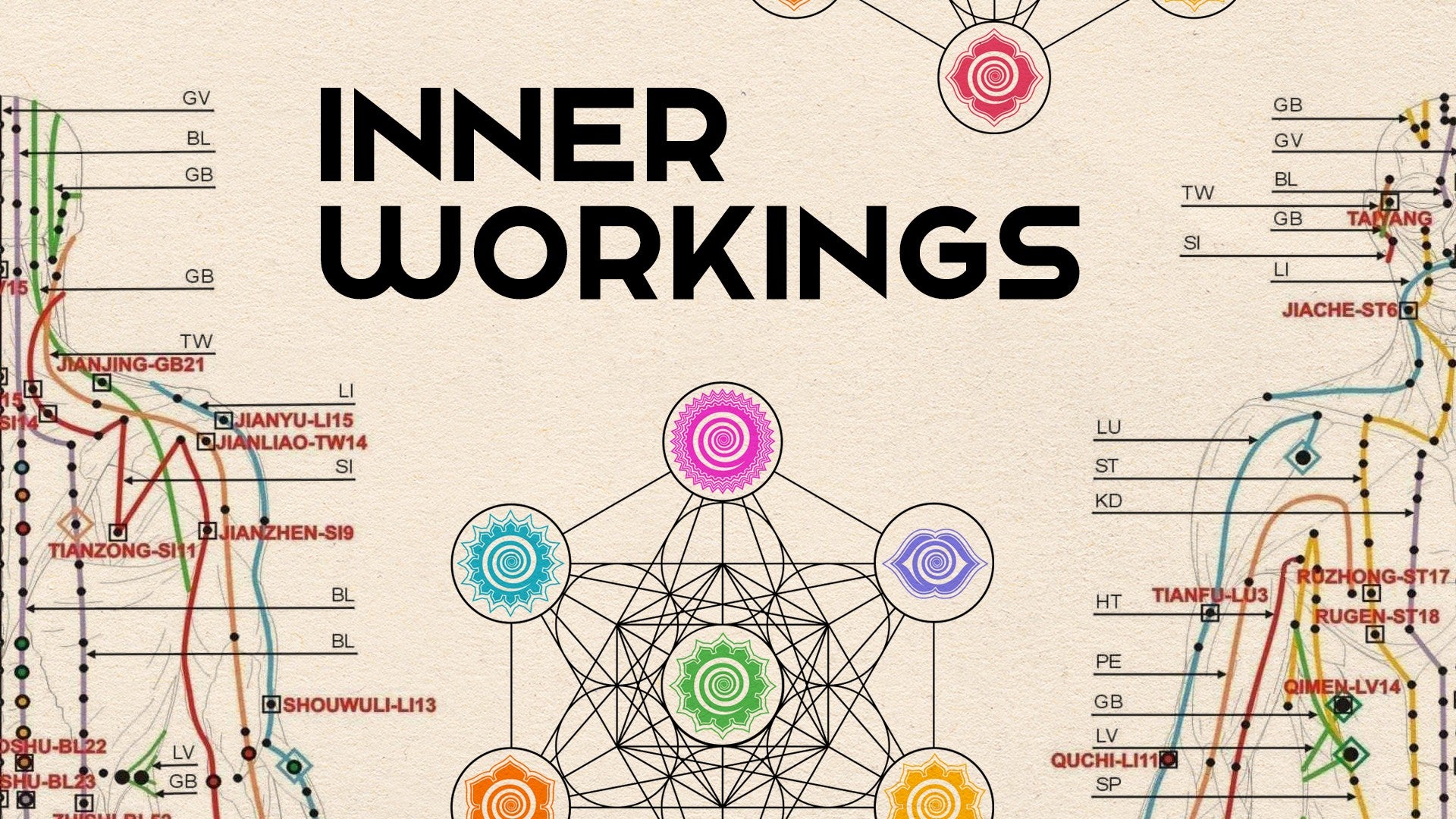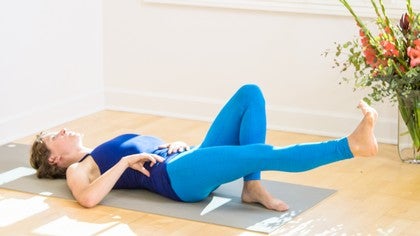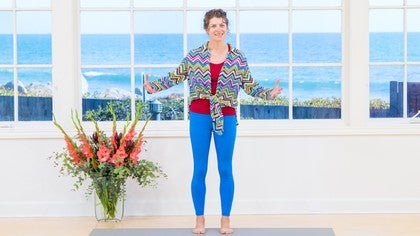Description
About This Video
Transcript
Read Full Transcript
In an earlier episode, we explored the location of the psoas and I made some exciting claims about its possibilities. In this episode, we're going to do some work just feeling it, feeling it in the body, exploring movement. So in an earlier episode, we did work with constructive rest position, which really speaks to the psoas. And I really invite you, if you become interested in this work or if you find it to be helpful to you, to experiment with doing CRP before you do this work and see if it's different for you and how it's different. It makes a big difference for me.
So let's get started. You'll come down into your back and plant the soles of the feet just as though you were going to do constructive rest position. The palms are up, the arms are by your sides. All we're going to do at first is feel with the hands for the location of the psoas. So the psoas is very deep inside the body, but you can trace the fingers along the skin and it will give you a sense of the pathway.
From T12, which is just at the bottom of the rib cage, you can finger the inside edge of the front of the rib cage where the diaphragm is and imagine the back, bottom rib. The psoas attaches to the spine all along on both sides, spiraling down and travels across the hip socket and to the lesser trochanter, which is on the upper inner thigh bone, a little bump that's about at the level of the floor of the pelvis. You can feel for the iliacus with the fingers, here's the iliac crest. The iliacus lines the iliac crest and interweaves with the psoas as it comes across the pelvis and comes down and connects to the lesser trochanter. So you can place the hands just over the iliac arches and over the hip sockets and feel through the body just for a moment.
Basically what you're feeling for is any work that you're doing, any tension that you're holding that you might be able to let go of. If right now isn't the time, that's fine. But if there's anything that you're doing that you might be able to not do underneath your hands, you can just let go. And then you'll let the left foot float up so that the knee comes toward the chest and you can set it down again. And you'll let the right foot float up and set it down again.
Now from here where the hands are resting on top of the socket, I want you to move them around and place them under the low back. They'll just fit in there. If your lumbar spine is pressed all the way down into your hands already, then go do the CRP video. If being here, your low back hurts because it's pushed away from the hands so much, go do the CRP video. The quality of your orgasm is on the line.
You can lift your foot here and feel the changes in your low back with your hands. Right foot comes up, moves toward the chest, back down. You can do the left foot a couple times, you can do the right foot a couple times. What you're feeling for is whether or not the space underneath the lumbar spine changes when you're moving the leg. And you might be able to feel that for a while it doesn't and that it does in one direction or the other.
The movement of the spine indicates that at a certain point the movement stops coming from the hip socket and starts coming from the pelvis. And our goal in the movement exercise is to try to have the pelvis be able to stay as still as possible. That doesn't mean that I want you to hold your pelvis still. So you're just stepping with the feet and you're feeling underneath the back and you're seeing if there's anything that you're doing that you might not need to do. And then you can come down and pause with the soles of the feet resting on the floor.
And then again soften over the hip sockets along the spine all the way down to the upper inner thigh. And then again starting with the left foot you'll pick up the left foot and let the knee float up and toward you and we'll start to unfold the leg. You can fold it back down and lower the foot to the floor. In the right foot it floats up and you start to unfold the leg. For some of us if the hamstring pulls a lot here you may not straighten the leg all the way out.
It's alright if it stays partially bent. If it's comfortable for the leg to come all the way straight you can do that and we're going to just keep moving through that pattern and we're looking for excess motion. So does the pelvis need to rock side to side to accomplish the motion? Is the abdomen soft? Could it be softer?
Moving back and forth, letting the foot float and the knee come in, extending the sole of the foot toward the ceiling, bending the knee again, returning the sole of the foot to the floor, back to the other side. So it's a repetitive motion and you can just trust your body to do it and feel through the hands underneath you or the hands on the belly or where you might be able to do less. And once you're evened out we'll stop and you can rest again. Now we're going to glide the heel forward on the floor. I have this handy wood floor here that my heel slides on really easily.
If you have one of those please use it. You can also experiment with wearing socks. We'll start again on the left. So the left foot comes onto your slippery surface or you can take your time and put your socks on. And the foot's just going to glide away from you and back in.
And you can choose if you want to alternate the legs or do one for a little bit and then switch. In my body I can feel that on the right side when the leg extends all the way out the pelvis is pulled forward into anterior tilt to accomplish the extension of the leg. And just noticing that, just noticing the actual experience of the pelvis being pulled with the leg, I'm honing a practice of proprioception, of awareness and attention around the right psoas, and then you bring both feet in and rest. And here too I can feel a tiredness in the right side that I don't feel in the left side. And pausing and noticing the quality of that is information and also drawing attention to that area gives my body the extra opportunity to nourish it.
And then we'll make a whole cycle. So the left foot lifts up and the leg extends. And then we're going to lower the leg. And this is where the pieces that we've been putting together, it sort of gets more challenging. So if somewhere earlier along the line you found, like I did, that there was a piece that really took some movement in your pelvis, you couldn't accomplish it without moving the pelvis, you might find that this is more than you need to do.
The heel lifts, the leg floats all the way down to the floor, and the heel drags in. And then on the other side, the foot floats, the leg extends, the heel lifts, and the leg travels all the way down to the floor. If you get a consistent hip pop, for example, in this cycle, I suggest that you don't just keep moving through it. Instead, find your way to an exercise where you had more choices, like just the foot lifting, or just the unfolding, or just the gliding, and see if you can move through that range of motion with a little bit less effort. One leg at a time.
We'll finish out on this cycle, so the leg unfolds, and you lower, and the heel comes in, reach up, lower, and the heel comes in. So we'll pause here, and what's the alternative to a lot of effort, right? You can come around onto your side and sit up. In yet another episode, I talked about eccentric and concentric contraction, and that's really where I go in this practice, when I want to find another way to be inside my body, other than my habitual effort. Extending the psoas, the psoas is considered an eccentric muscle.
So when it's toned, it doesn't shorten. That's not its behavior. When you use it, when you activate it, its activating tendency is to lengthen. If that's a hard feeling to get inside the body, that's really good information to have. And these small, simple explorations are a great way to feel into a different way of being strong.
Inner Workings: Devon Riley
Comments
You need to be a subscriber to post a comment.
Please Log In or Create an Account to start your free trial.















